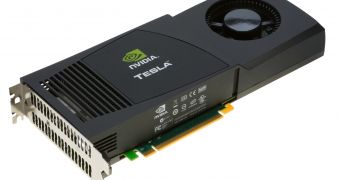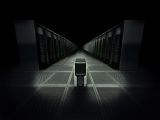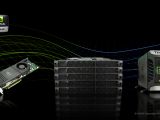The latest news on the Web points towards the fact that some PC vendors are about to bring to the market desktop supercomputers that will feature Nvidia’s Tesla floating point accelerators. These PCs are expected to have a price tag set around the $10,000 point, while being able to deliver great horsepower, reaching a maximum of 4 TFlops of single-precision processing in theory.
Technology enthusiasts know that, a few years ago, a similar idea emerged from the Orion Multisystems. The company tried to come with a $100,000 desktop tower which featured 96 Transmeta Efficeon processors as a potent workstation, yet the idea failed to come to life. Moreover, Nvidia also introduced the $7500 Tesla (D870) deskside case packed with two C870 gen 1 cards (518 GFlops each) in late 2006, yet the D870 had a limited success, and the company ended the project with the new, gen 2 Tesla family.
We have just learned that Nvidia is returning with a new deskside supercomputer, one that may prove more useful than the predecessor. The Santa Clara-based company unveiled a reference platform of a capable Tesla desktop and is said to have convinced computer makers like Dell, Asus, Lenovo, Scan and Boxx to configure and bring to the market such PCs under their brand names. These desktops are supposed to feature four Tesla cards. Unlike D870, these desktops are fully functional, and Nvidia says that, besides the four C1060 cards, a quad-core CPU and 16GB of memory are recommended. The company also reveals that the entire cost of the desktop should not rise above $10,000.
Such a desktop supercomputer would pack inside 960 graphics cores, while the combined performance rating should rise to about 3.6 to 4 TFlops in single-precision and to about 400 GFlops in double-precision applications. The C1060 GPUs (T10P processor) sport a 1.33GHz clock speed and rated performance of about 900 GFlops in a single-unit configuration.
According to Nvidia, a Tesla PC will be able to perform about 250 times faster than a regular desktop PC, but that would depend on the application performed. On the other hand, the performance level would depend on the system it is compared to as well. The point is that a computer that features an Nvidia SLI system or two of ATI’s Radeon HD 4870 X2 cards is able to easily compete with a Tesla PC when it comes to Teraflops. Moreover, according to ATI, its two 4870 X2 cards would provide about 2.4 TFlops in single-precision and would be able to outperform the four Tesla cards in double-precision applications, while reaching a maximum performance of about 480 GFlops.
The Tesla system packs 4 GB of GDDR3 800 memory in each CPU, translated into a total of 16 GB of graphics memory for the entire system, outpacing regular graphics cards. The Tesla system also features a combined memory bandwidth of 408 GB/s, yet all that processing power the system is capable of is complemented by substantial power consumption as well. Each C1060 card is rated at 160 watts, meaning that four cards and a capable processor can go to 750 watts easily.
Nvidia’s Tesla product line seems to be naturally expanding into the Tesla supercomputer, while also offering the manufacturer the chance to sell more of its cards. It is also likely that there will be organizations considering the $10,000 supercomputer an advantageous deal.

 14 DAY TRIAL //
14 DAY TRIAL // 

